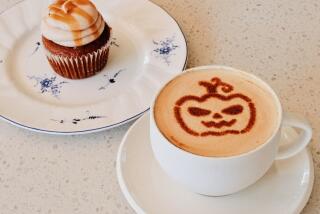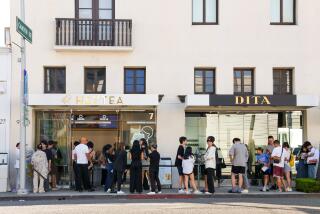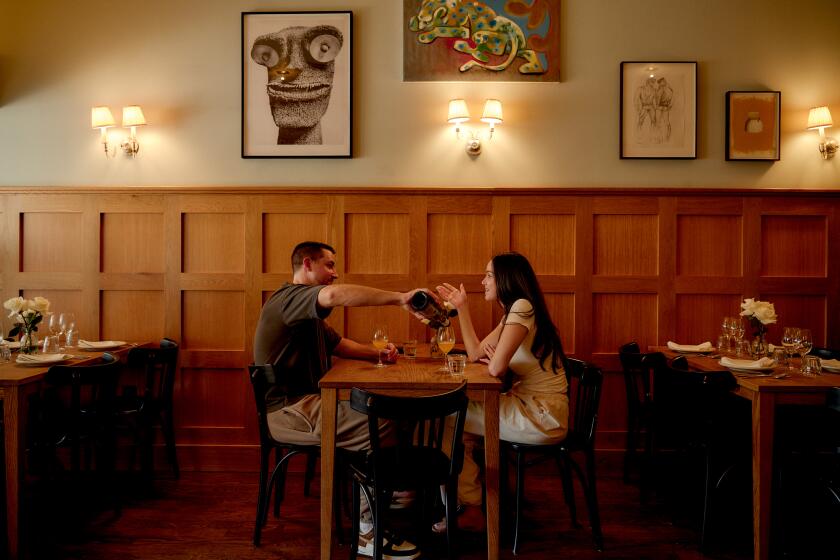It’s Teatime for Coffee-Soaked Pacific Northwest
PORTLAND, Ore. — There’s something brewing in the Pacific Northwest, and, this time, it’s not coffee.
It’s tea. And although it hasn’t taken off with the fervor of a caffeine buzz, the tea revolution is taking hold.
It’s not just that warm liquids go well with a cool, rainy climate. Experts say some of the same consumers in Portland and Seattle who demanded a better cup of coffee are developing a more refined taste for tea.
Formal afternoon teas are becoming an increasingly popular alternative for business meetings and after-work gatherings. And tea houses are quietly opening in a market long saturated with coffee cafes.
“It’s not the fast-paced ‘grab a cup and run,’ ” said Sarah Bennett, who runs the British Tea Gardens in Portland with her mother, Judith, and another partner. “It’s something that adds to conversation. People come here and really let their worries go for a while.”
The women, all from England, started with a gift shop three years ago. “But people kept coming in and asking for tea,” said Judith Bennett, whose menu includes crumpets, scones and the occasional steak and kidney pie specials.
She has opened a second shop in Portland, including a growing mail-order business with more than 300 varieties of tea from China, India, Australia and other parts of the world.
“If I didn’t do it, I know someone else would,” she said.
It’s a testament to the growing taste for variety--from the traditional Earl Grey to fancy Formosa Oolong, smoky Lapsang Souchong and tangy Ceylon Orange Pekoe. Green teas also are growing in appeal, as is chai (black tea with milk and spices) and fermented tea, which is sold on tap in bars.
Even Starbucks, the Seattle-based coffee king, now sells a few varieties of tea.
“Oh, thank goodness,” said Claudia Groth of Portland. “We tea drinkers are tired of not being able to walk down the street with some trendy drink. You’re kind of left out of the social thing.”
*
Groth drinks at least one cup of Earl Grey each day. But otherwise, she’s as happy with a cup of McDonald’s iced tea as a fancy tea from such companies as Portland-based Stash Teas, and relative newcomers Republic of Tea, based in Navarro, Calif., and Tazo Teas, also based in Portland.
Experts say a growing number of people are switching, especially in the afternoon and evening, because of tea’s lower caffeine content.
Still others in the Pacific Northwest, including Melanie Kelly of Seattle, finally are able to admit that they simply never liked coffee.
“It’s not the caffeine. It’s the beans, for cripes sake,” Kelly said. She has just discovered a new tea cafe in Seattle’s Pike Place Market--the same place Starbucks Coffee opened its first cafe in the late 1960s.
The progression from coffee to tea is not surprising to Frank Miller, president of the Blue Willow Tea Co. in Seattle.
“They are beverages that seem to go hand in hand with one another,” he said.
In the 1700s in Europe, coffee replaced ale as a morning beverage for the masses, Miller said, after the Dutch and traders brought beans from the Middle East. As sea travel increased and became less expensive, tea finally made its debut--but not until coffee houses had taken over Europe.
Tea did become more popular in some countries, especially England.
That hasn’t happened in the United States, where people drink the bulk of their tea in iced form. But the tea industry continues to grow, from $1.8 billion in sales in 1990 to $3.75 billion in 1994, according to the Tea Council of the U.S.A., based in New York.
The fastest growth is among ready-to-drink and specialty teas.
“The bright light is premium products,” said Steve Smith, who founded Tazo Teas two years ago.
*
His line of products includes “micro-brewed” bottles of tea, which he distributes to such places as New York’s Guggenheim Museum. He also has opened several “tea bars” in specialty supermarkets, at universities--from Portland State to Harvard--and at the Beaverton headquarters of Nike Corp.
In the specialty tea segment, Tazo is concentrating on putting a better grade of tea into bags. Meanwhile, companies such as Blue Willow Tea are concentrating exclusively on loose tea.
Both versions are selling, said Shannon Loch, a buyer for Nature’s Fresh Northwest, a natural and specialty foods chain with stores in Oregon and Washington. Consumers are buying more tea whether they take tea bags to work or keep loose tea at home for more leisurely moments, she said.
“People are looking for ways to create rituals and traditions in their lives,” Loch said, from boiling the water to choosing the tea and serving it.
That ritual is especially true in the Pacific Northwest, she said, adding, “Here, we find ways to set off the gray days.”
More to Read
Eat your way across L.A.
Get our weekly Tasting Notes newsletter for reviews, news and more.
You may occasionally receive promotional content from the Los Angeles Times.










